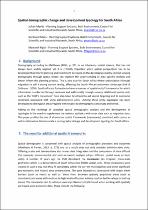JavaScript is disabled for your browser. Some features of this site may not work without it.
- ResearchSpace
- →
- Research Publications/Outputs
- →
- Conference Publications
- →
- View Item
| dc.contributor.author |
Maritz, Johan

|
|
| dc.contributor.author |
Mans, Gerbrand G

|
|
| dc.contributor.author |
Ngidi, Mawandi

|
|
| dc.date.accessioned | 2021-08-05T11:49:46Z | |
| dc.date.available | 2021-08-05T11:49:46Z | |
| dc.date.issued | 2017-11 | |
| dc.identifier.citation | Maritz, J., Mans, G.G. & Ngidi, M. 2017. Spatial demographic change and development typology for South Africa. http://hdl.handle.net/10204/12071 . | en_ZA |
| dc.identifier.uri | http://hdl.handle.net/10204/12071 | |
| dc.description.abstract | Demography according to Matthews (2013, p. 271) is an inherently spatial science, that has not always been widely applied, yet it is critically important when spatial perspectives has to be developed that inform planning and investment decisions. In the developing country context viewing demography through spatial lenses can improve the understanding of area specific realities and better inform the planning process. This is also true for South Africa where urbanisation (through migration) is still a strong current reality, affecting the South African settlement landscape (Kok & Collinson , 2006). South Africa is fortunate to have a number of spatial units/ frameworks for which information is collected through censuses and additionally through surveys. Additional spatial units such as the ‘CSIR’s mesozones’ have also been developed to aid spatial targeting and to overcome constrains associated with using administrative units. Utilising these units, typologies has been developed to distinguish areas/regions with respect to demographic constructs and trends. Adding to the challenge of complete spatial demographic analysis and the development of typologies is the need to supplement the national statistics with other data such as migration data. This paper profiles the use of alternative spatial frameworks (mesozones) combined with census as well as alternative data to create a demographic change and development typology for South Africa. | en_US |
| dc.format | Fulltext | en_US |
| dc.language.iso | en | en_US |
| dc.source | XXVII IUSSP International Population Conference, Cape Town, 29 Oct - 3 Nov 2017 | en_US |
| dc.subject | Mesozone | en_US |
| dc.subject | Settlement landscape | en_US |
| dc.subject | Spatial units | en_US |
| dc.subject | Spatial framework | en_US |
| dc.subject | Typologies demographic constructs | en_US |
| dc.title | Spatial demographic change and development typology for South Africa | en_US |
| dc.type | Conference Presentation | en_US |
| dc.description.pages | 5 | en_US |
| dc.description.note | Paper presented at the XXVII IUSSP International Population Conference, Cape Town, 29 Oct - 3 Nov 2017 | en_US |
| dc.description.cluster | Smart Places | |
| dc.description.impactarea | Urban and Regional Dynamics | en_US |
| dc.identifier.apacitation | Maritz, J., Mans, G. G., & Ngidi, M. (2017). Spatial demographic change and development typology for South Africa. http://hdl.handle.net/10204/12071 | en_ZA |
| dc.identifier.chicagocitation | Maritz, Johan, Gerbrand G Mans, and Mawandi Ngidi. "Spatial demographic change and development typology for South Africa." <i>XXVII IUSSP International Population Conference, Cape Town, 29 Oct - 3 Nov 2017</i> (2017): http://hdl.handle.net/10204/12071 | en_ZA |
| dc.identifier.vancouvercitation | Maritz J, Mans GG, Ngidi M, Spatial demographic change and development typology for South Africa; 2017. http://hdl.handle.net/10204/12071 . | en_ZA |
| dc.identifier.ris | TY - Conference Presentation AU - Maritz, Johan AU - Mans, Gerbrand G AU - Ngidi, Mawandi AB - Demography according to Matthews (2013, p. 271) is an inherently spatial science, that has not always been widely applied, yet it is critically important when spatial perspectives has to be developed that inform planning and investment decisions. In the developing country context viewing demography through spatial lenses can improve the understanding of area specific realities and better inform the planning process. This is also true for South Africa where urbanisation (through migration) is still a strong current reality, affecting the South African settlement landscape (Kok & Collinson , 2006). South Africa is fortunate to have a number of spatial units/ frameworks for which information is collected through censuses and additionally through surveys. Additional spatial units such as the ‘CSIR’s mesozones’ have also been developed to aid spatial targeting and to overcome constrains associated with using administrative units. Utilising these units, typologies has been developed to distinguish areas/regions with respect to demographic constructs and trends. Adding to the challenge of complete spatial demographic analysis and the development of typologies is the need to supplement the national statistics with other data such as migration data. This paper profiles the use of alternative spatial frameworks (mesozones) combined with census as well as alternative data to create a demographic change and development typology for South Africa. DA - 2017-11 DB - ResearchSpace DP - CSIR J1 - XXVII IUSSP International Population Conference, Cape Town, 29 Oct - 3 Nov 2017 KW - Mesozone KW - Settlement landscape KW - Spatial units KW - Spatial framework KW - Typologies demographic constructs LK - https://researchspace.csir.co.za PY - 2017 T1 - Spatial demographic change and development typology for South Africa TI - Spatial demographic change and development typology for South Africa UR - http://hdl.handle.net/10204/12071 ER - | en_ZA |
| dc.identifier.worklist | 24783 | en_US |






